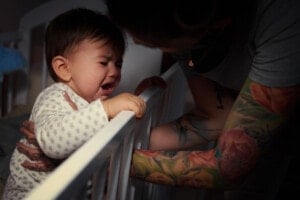Screen time for kids is a topic on every parent’s mind because it has been getting a lot of press through the newly affirmed restrictions from the World Health Organization (WHO). The WHO and the American Academy of Pediatrics (AAP) have been very vocal lately in urging parents to restrict screen time for kids under five severely.1,2,3 The latest recommendations are for children under two years to have no screen time and for children between two and five to have no more than an hour per day.4,5 This can be quite a challenge when screens are a pervasive part of our world.
Why Limit Screen Time for Kids
These organizations’ primary objective is to encourage physical activity, healthy social interactions between children and caregivers, and for children to get plenty of sleep. The suggested screen time limitations for kids will help parents meet these critical goals. Let’s look at when these concepts are best practiced for optimal early child development.
When to Say No to Screen Time for Kids
During Breakfast
A good time to skip screen time for kids is during the early morning cartoons. Morning is a great time for physical activity. Maybe you can set up a “wake-up routine” of jumping jacks, running in place, an obstacle course, or dancing to loud music. You could also replace TV time with a morning walk or playing outdoors. Research shows that when children engage in physical activity in the morning, it helps them focus throughout the day. In a recent study, kindergarteners and first graders allowed physical activity during their school day were more focused, and teachers could move on to new material faster. There were fewer disruptions from students in the class.6,7
On Your Commute
Those mini TV screens in cars are great for long trips, but when children turn on the screen as soon as they get into the car, they miss out on tons of learning experiences and opportunities for interactions. Car rides are a great time to talk, interact, and share thoughts and ideas. You can play I Spy with your child while driving, picking out items on the landscape to find and guess. This challenges children’s visual skills, which continue to refine until after a child’s fifth birthday.
Car rides are also a great time to connect with your child, regardless of age. Babies will enjoy listening to your voice as you talk, tell stories, and sing songs (yes, even singing along with the radio is excellent). You teach your baby the pause and flow of conversation and new vocabulary.
Older children can be engaged in little games such as “How many animals can you name that live on land?” “How many animals can you name that live in water?” Challenge their creativity, imagination, and ability to articulate their answers.
It is also important to remember that you are starting to teach your child to drive just as soon as you turn that car seat around. They are watching, learning, and modeling after you from a very young age. By practicing good habits, such as not texting and driving, you are setting an amazing example for your child.
At the Grocery Store
It might be boring for your child while you compare the prices of ketchup, but watching a video or playing LEGO DUPLO train on your phone is causing your child to miss out on great learning opportunities. The grocery store is full of colors, shapes, items to count, textures to feel, sounds to hear, letters, numbers, and patterns. Young children sitting in the cart are nice and close to you for interactions. Older children can be given circulars or coupons to find items. Or a scavenger hunt to find items, colors, and shapes. They can also find patterns and use math to add items, prices, and servings. The possibilities are endless!
At Bedtime
This is a great time to connect with your child. Make bedtime a loving routine. Maybe it’s bath time, then read a book together. Sing a song, talk about the best part of your days, and kiss goodnight. Studies show that children who fall asleep watching a screen take longer to fall asleep and do not have restful sleep.8 Deep, restful sleep is critical for growth and development. Often, sleep deprivation is the source of illness and behavioral issues in young children. By keeping screens out of the bedtime routine, you can bond and ensure more restful sleep.
It is virtually impossible to avoid the virtual world that screens provide entirely. Still, we can think about the times of the day when screens cause the most missed opportunities and focus on replacing those virtual experiences with real ones!































